A fresh coat of paint transforms spaces‚ enhancing ambiance and durability. Guide Paint offers expert advice on color choice‚ finishes‚ and techniques‚ ensuring professional results and long-lasting beauty.
Why Your Choice of Paint Matters
Your paint choice significantly impacts both aesthetics and durability. The right color and finish enhance ambiance‚ while poor choices may fade quickly or lack longevity. Professional guidance ensures selections align with your vision‚ style‚ and space‚ creating cozy or energized moods. Proper paint selection prevents premature wear and maintains a fresh look‚ making it a crucial investment for indoor and outdoor transformations. Expert advice helps avoid costly mistakes‚ ensuring a professional finish that withstands time and environmental factors;
Understanding Paint Types and Finishes
Paint types vary‚ with options like Solid‚ Metallic‚ Pearl/Mica‚ and Basecoat Paints‚ which require a clear coat for gloss. Finishes range from matte to high-gloss‚ affecting durability and aesthetics. Choosing the right type and finish ensures longevity and style alignment. Professional advice helps select paints that match your vision‚ whether for indoor ambiance or outdoor weather resistance‚ guiding you through color selection and finish suitability for a polished‚ professional result that enhances your space’s beauty and functionality.

Preparation for Painting
Proper preparation is key to a successful paint job. Clean surfaces thoroughly‚ remove hardware‚ and protect surrounding areas to ensure a smooth‚ professional finish every time.
Surface Cleaning and Readiness
Proper surface preparation is essential for a successful paint job. Start by thoroughly cleaning the area with a mild detergent mixed with water to remove dirt‚ grease‚ and grime. Avoid using harsh chemicals that could damage the surface. Lightly scuff glossy surfaces to ensure better paint adhesion. Rinse the area well and allow it to dry completely before applying primer or paint. This step ensures a smooth‚ even finish and long-lasting results. Clean surfaces are the foundation of a professional-looking paint job.
Hardware Removal and Area Protection
Before painting‚ remove hardware like doorknobs‚ light switches‚ and outlet covers to prevent paint splatters. Cover floors‚ furniture‚ and fixtures with drop cloths or plastic sheets to protect them from stains. Use painter’s tape to mask off trim‚ baseboards‚ and moldings for crisp‚ clean edges. Ensuring these steps are done meticulously saves time and effort‚ preventing costly repairs and ensuring a professional finish. Proper protection guarantees a stress-free painting experience and preserves surrounding surfaces.
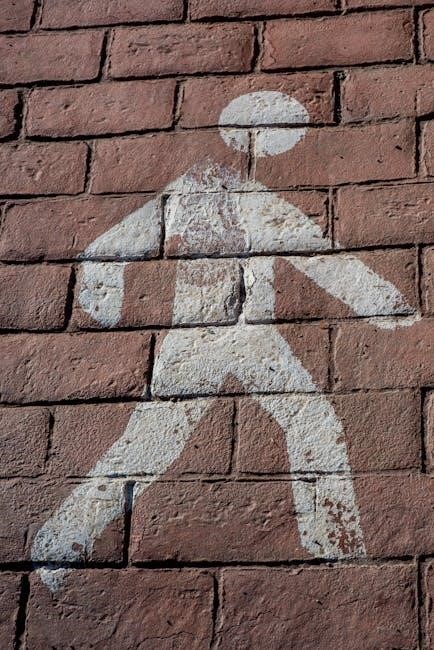
Paint Application Tips
Use high-quality brushes or rollers for smooth‚ even coverage. Apply paint in thin‚ steady strokes‚ working in sections to maintain consistency and avoid drips. Start with light layers‚ allowing each to dry before adding more for optimal results and a professional finish.
Choosing the Right Tools and Brushes
Selecting the appropriate tools is crucial for a professional finish. Natural-bristle brushes are ideal for oil-based paints‚ while synthetic fibers work best with water-based options. Rollers are great for large surfaces‚ ensuring quick coverage. For smooth finishes‚ use high-quality brushes with tapered bristles. Airbrushes or sprayers can achieve precise‚ even coats on intricate designs. Always match the tool to the paint type and surface for optimal results. Proper tool maintenance extends their lifespan and ensures consistent performance across projects.
Layering and Coverage Techniques
Proper layering ensures even coverage and durability. Apply thin‚ even coats‚ allowing each layer to dry completely before adding the next. This prevents peeling and uneven textures. Use the W or M pattern with rollers for smooth coverage. Brushes should be worked in the direction of the surface grain for uniformity. Avoid overloading tools with excess paint to maintain control. Lightly feathering edges ensures seamless transitions between sections. Adequate drying time between coats is key for a professional‚ long-lasting finish.
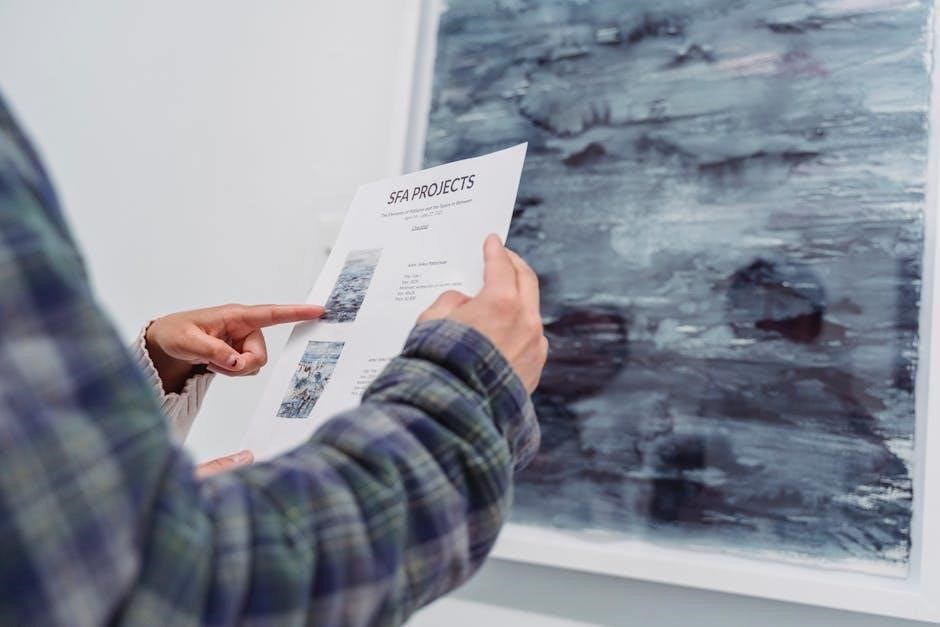
Drying and Curing Times
Drying and curing times vary by paint type and environmental conditions. Drying is surface evaporation‚ while curing involves chemical reactions for hardness. Temperature‚ humidity‚ and airflow impact both processes‚ requiring patience for a durable finish.
Factors Affecting Drying Time
Temperature‚ humidity‚ and airflow significantly influence paint drying time. Higher temperatures and good ventilation speed up the process‚ while high humidity slows it down. Paint type also matters‚ as latex dries faster than oil-based. Thicker coats take longer to dry‚ and certain colors or finishes may extend drying time. Environmental conditions and application thickness are critical for achieving optimal results. Always follow manufacturer guidelines for best outcomes. Proper conditions ensure a smooth‚ even finish. Patience is key for lasting durability.
Ensuring Proper Curing for Durability
Proper curing is essential for paint durability‚ requiring patience and ideal conditions. Allow the paint to cure fully‚ as specified by the manufacturer‚ typically ranging from 7 to 30 days. Avoid exposing the surface to moisture‚ heat‚ or heavy use during this period. Ensure good ventilation and maintain moderate temperatures. Lightly sanding before curing can enhance adhesion. Following these steps ensures a hard‚ resilient finish that withstands wear and tear. Proper curing is key to a long-lasting‚ professional result.
Maintenance and Touch-Ups
Regular maintenance extends paint lifespan. Clean surfaces‚ inspect for damage‚ and touch up scratches or fading promptly. Schedule periodic checks to prevent deterioration and ensure longevity.
Regular Care for Longevity
Regular maintenance ensures your paint retains its appearance and durability. Clean surfaces with mild detergents to remove dirt and grime. Inspect for cracks or peeling and address promptly. Avoid harsh chemicals that can damage finishes. Use soft cloths to prevent scratches. In high-moisture areas‚ prevent mold growth by ensuring good ventilation. Touch up minor damage quickly to prevent further deterioration. Shield exterior paints from direct sunlight and weathering by applying protective sealants when needed. Proper care extends the lifespan of your paint‚ maintaining its vibrancy and protection.
When and How to Touch Up Paint
Touch up paint when small scratches or fading appear to maintain a fresh look. Use matching paint for consistency and blend edges for a seamless finish. Lightly sand damaged areas to ensure adhesion. Apply thin coats‚ allowing each to dry before reapplying. For best results‚ test the paint on a small‚ inconspicuous area first. Address chips or cracks promptly to prevent further damage. Regular touch-ups preserve the appearance and protect surfaces from wear and tear‚ ensuring long-lasting results and a professional finish.
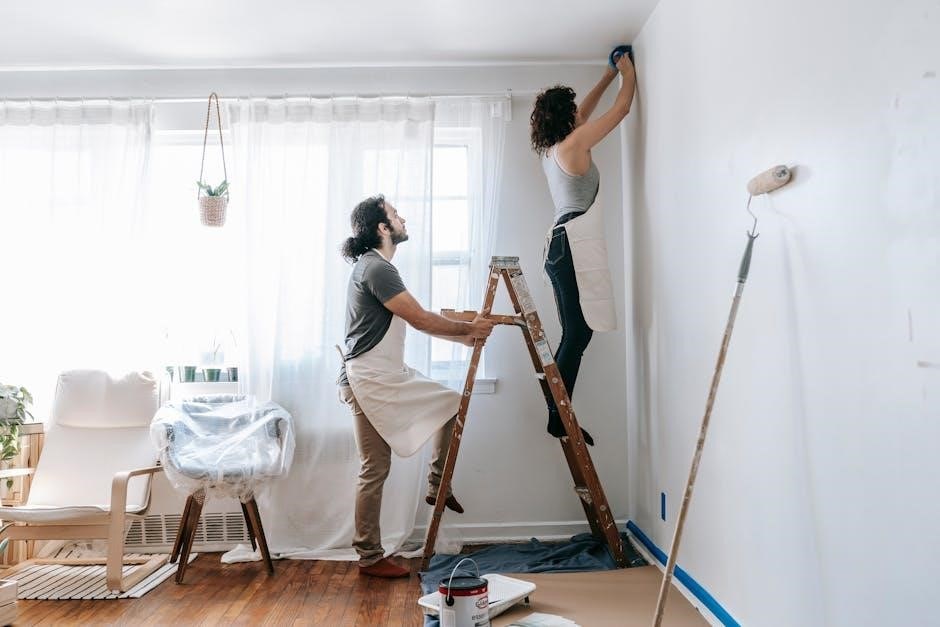
Color Psychology in Painting
Colors deeply influence emotions and ambiance. Warm tones like red and orange energize spaces‚ while cool blues and greens create calm. Strategic color choices enhance mood and aesthetics.
Impact of Colors on Mood and Ambiance
Color psychology significantly influences emotions and spatial atmosphere. Warm tones like reds and oranges evoke energy and warmth‚ ideal for active areas. Cool shades such as blues and greens promote relaxation‚ perfect for serene spaces. Soft neutrals‚ including beiges and grays‚ create balance and calmness. Bright colors can energize‚ while muted tones offer sophistication. Understanding these effects allows for tailored color choices to enhance mood and ambiance in any room‚ fostering desired emotional responses and aesthetic harmony.
Harmonizing Colors for Aesthetics
Harmonizing colors creates visually pleasing spaces by balancing hues. Techniques like complementary‚ analogous‚ or triadic color schemes ensure cohesion. The 60-30-10 rule suggests using a dominant color (60%)‚ a secondary shade (30%)‚ and an accent color (10%) for balance. Neutral tones act as a unifying base‚ while contrast enhances visual interest. Testing paint samples on walls helps finalize choices‚ ensuring the palette aligns with the desired aesthetic and atmosphere‚ creating a space that feels both beautiful and functional.
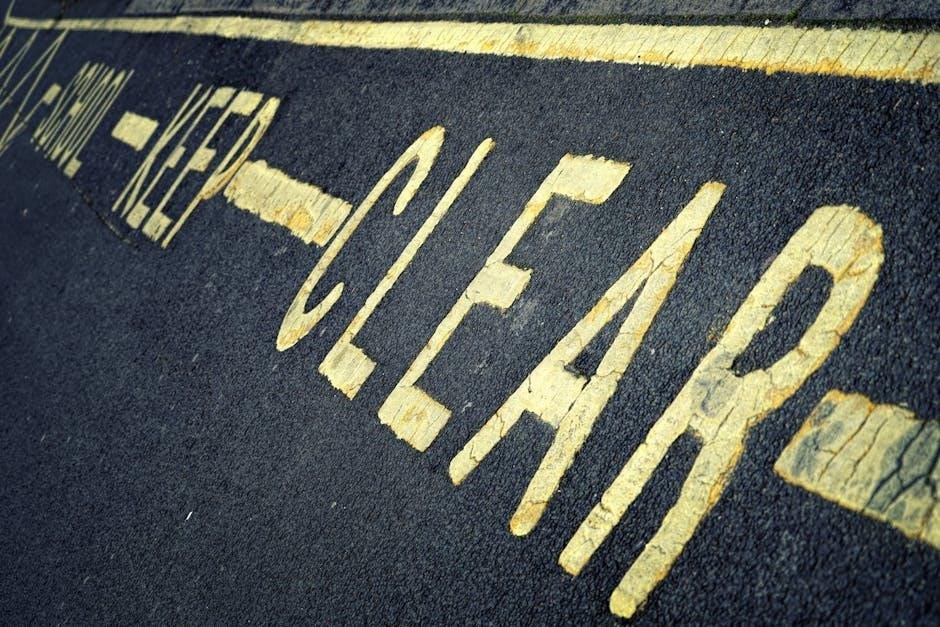
Professional Advice and Guidance
Seek expert tips and resources for professional finishes. Consulting with color strategists and painters enhances your painting process‚ ensuring high-quality results tailored to your needs.
Consulting Color Strategists
Color strategists offer expert advice to select hues that align with your space’s mood‚ lighting‚ and personal style. They use color wheels and swatches to create harmonious palettes‚ ensuring a cohesive look. By understanding psychological effects of colors‚ they help choose shades that enhance ambiance and functionality. Their insights can elevate your project‚ making spaces feel more inviting and reflective of your vision. Consulting professionals saves time and ensures a polished‚ professional result tailored to your needs.
Expert Tips for Professional Finishes
To achieve professional-looking results‚ sand surfaces thoroughly before painting and use high-quality tools. Apply paint in thin‚ even coats‚ allowing proper drying time between layers. Work in well-lit‚ ventilated areas to maintain consistency. Inspect your work regularly and address imperfections promptly. For smooth finishes‚ avoid overworking the paint. Use reference images to maintain uniformity. Finally‚ clean tools immediately after use to ensure longevity. These practices ensure a polished‚ professional finish that lasts.

Exterior Painting Considerations
Exterior painting requires careful planning due to weather exposure and material durability. Choose weather-resistant paints and prepare surfaces thoroughly to ensure long-lasting results and protection.
Choosing Durable Exterior Paints
When selecting exterior paints‚ prioritize durability and weather resistance. Opt for high-quality latex or oil-based paints designed to withstand moisture‚ UV rays‚ and temperature fluctuations. Consider finishes like satin or semi-gloss‚ which offer better protection and ease of cleaning. Look for paints with additives like mildewcide and UV blockers to enhance longevity. Ensure the paint is suitable for your climate and surface type‚ whether wood‚ metal‚ or stucco. Proper adhesion and color retention are key for a long-lasting exterior finish.
Weatherproofing and Protection
Weatherproofing is essential to protect exterior surfaces from environmental damage. Use paints with built-in waterproofing properties or apply a waterproofing primer. Regularly inspect and maintain painted areas to prevent cracks and peeling. Apply a clear sealant to enhance protection against UV rays and moisture. Ensure proper surface preparation to promote paint adhesion and longevity. Address any signs of wear promptly to maintain the protective barrier and prevent structural damage from weather exposure.
DIY Painting Projects
DIY painting involves careful planning‚ selecting the right tools‚ and proper surface preparation. Following step-by-step guides helps beginners achieve professional-looking results with minimal mistakes and maximum efficiency.
Step-by-Step Guides for Success
Effective DIY painting starts with a clear plan. Begin by assessing the project’s scope‚ gathering materials‚ and preparing surfaces thoroughly. Break tasks into manageable steps‚ such as cleaning‚ taping‚ and priming. Apply paint in thin‚ even layers‚ allowing proper drying time between coats. Use high-quality tools for smooth finishes. Avoid common mistakes like skipping prep work or using low-quality paints. Follow tutorials or videos for specific techniques‚ and test samples on small areas first. Proper sequencing ensures professional-looking results and minimizes errors.
Common Mistakes to Avoid
Avoid skipping surface preparation‚ as it leads to uneven finishes. Applying too much paint at once causes drips and uneven drying. Not waiting for proper drying times between coats can result in peeling or tacky surfaces. Using low-quality tools or the wrong brush for the job can compromise results. Taping too tightly or removing it too soon can peel paint. Forgetting to test paint samples may lead to color mismatches. Lastly‚ ignoring weather conditions‚ like humidity or direct sun‚ can hinder paint adhesion and curing.

Current Trends in Painting
Explore the latest trends‚ such as eco-friendly paints‚ minimalistic designs‚ and smart coatings. These innovations enhance aesthetics and functionality‚ catering to modern preferences and environmental concerns.
Popular Colors and Techniques
Current painting trends emphasize neutral tones‚ soft pastels‚ and bold accent walls. Techniques like ombre‚ gradient effects‚ and geometric patterns add visual interest. Metallic finishes and texture effects are gaining popularity for modern aesthetics. Additionally‚ eco-friendly paints and sustainable methods are in demand. These trends reflect a shift toward personalized spaces that blend functionality with artistic expression‚ catering to diverse design preferences and environmental consciousness.
Sustainable Painting Trends
Sustainable painting trends focus on eco-friendly practices‚ prioritizing low-VOC and non-toxic paints. Natural ingredients like plant-based dyes and recycled materials are gaining traction. Energy-efficient production methods and biodegradable packaging are also becoming standard. These trends aim to minimize environmental impact while maintaining durability and performance. Consumers increasingly favor brands committed to sustainability‚ driving innovation in the industry and promoting greener painting solutions for homes and businesses alike‚ ensuring a healthier planet for future generations.
Eco-Friendly Painting Options
Eco-friendly painting options include low-VOC‚ non-toxic‚ and natural paints. Look for Greenguard Gold certification for safer‚ environmentally responsible choices that enhance indoor air quality and sustainability.
Low-VOC and Non-Toxic Paints
Low-VOC (volatile organic compound) and non-toxic paints are ideal for eco-conscious projects. These formulas minimize harmful emissions‚ improving indoor air quality and reducing health risks. Look for products labeled as “low-VOC” or “zero-VOC” to ensure safer alternatives. Non-toxic options are free from harsh chemicals like lead and formaldehyde‚ making them perfect for families‚ pets‚ and sensitive environments. Many brands now offer these eco-friendly choices‚ blending sustainability with performance for a healthier painting experience.
Environmental Impact Considerations
Paint production and disposal can significantly affect the environment. Traditional paints often contain VOCs and harmful chemicals that pollute air and water. Eco-friendly options‚ like water-based paints‚ reduce emissions and minimize ecological harm. Proper disposal of leftover paint and materials is crucial to prevent contamination. The paint industry is increasingly adopting sustainable practices‚ such as recycling and using biodegradable ingredients. Choosing environmentally responsible products helps protect ecosystems and promotes a greener future for painting projects.
Budgeting for Your Painting Project
Plan your painting budget by considering paint quality‚ tools‚ and labor costs. Compare prices and set realistic expectations to avoid cost overruns. Prioritize needs over wants to stay within budget constraints. A well-planned budget ensures a successful and stress-free painting experience. Allocate funds wisely to achieve desired results without financial strain or compromise on quality. Research cost-effective options to maximize your investment in your painting project. Consider DIY options to reduce labor costs if possible. Always include a contingency fund for unexpected expenses. Use online calculators or consult professionals to estimate material quantities accurately. Negotiate with suppliers for bulk discounts or seasonal offers; Balance between affordability and durability to ensure long-term satisfaction. Regularly review and adjust your budget as the project progresses to stay on track. This structured approach will help you manage finances effectively and complete your painting project successfully.
Cost-Effective Paint Choices
Opting for cost-effective paints doesn’t mean sacrificing quality. Consider mid-range options that offer durability and color retention at a lower price. Compare brands and finishes to find value for money. Look for sales‚ discounts‚ or bulk purchase incentives to reduce costs. Prioritize essential features over premium add-ons to stay within budget. Always check the paint’s coverage rate to avoid buying excess. A well-researched‚ budget-friendly choice ensures a beautiful finish without financial strain. Balance affordability with performance for lasting results.
Estimating Material Needs
Accurately estimating paint and materials ensures efficiency and avoids waste. Calculate surface area by measuring walls‚ ceilings‚ or surfaces to determine paint quantity. Consider multiple coats and surface texture for precise needs. Factor in primer‚ brushes‚ rollers‚ and trays. Use online calculators or consult experts for accurate measurements. Proper estimation prevents overspending and ensures sufficient supplies for a seamless painting process. Plan carefully to achieve professional results without excess materials. Always measure twice to get it right the first time.
Testing and Sampling Paint
Testing paint samples ensures color accuracy and finish suitability. Apply samples to small areas to preview results‚ avoiding costly mistakes. This step guarantees satisfaction with the final look.
Using Paint Samples Effectively
Paint samples are crucial for making informed decisions. Apply them to large‚ visible areas to gauge color and finish under different lighting conditions. Test on multiple walls to see how hues shift throughout the day. Allow samples to dry completely before assessing. This step ensures the chosen color aligns with your vision and complements the space. Comparing samples side by side helps identify subtle differences. It’s a simple yet effective way to avoid costly mistakes and achieve the desired aesthetic.
Testing Paint Adhesion and Durability
Testing paint adhesion and durability ensures long-lasting results. Apply paint to a small area and let it cure. Use a cross-hatch or tape test to check adhesion strength. Assess how well the paint withstands wear‚ moisture‚ and cleaning. Exposure to weather conditions like sunlight and rain can reveal durability. Proper surface preparation enhances adhesion‚ while poor preparation leads to peeling. Conducting these tests helps identify quality paints and avoids future repairs‚ ensuring a professional and enduring finish.

Health and Safety Considerations
Prioritize safety by wearing masks‚ gloves‚ and goggles when painting. Ensure good ventilation to avoid inhaling fumes. Store paint and materials safely‚ and dispose of them responsibly.
Safe Painting Practices
- Always wear a mask‚ gloves‚ and protective eyewear to minimize exposure to paint fumes and particles.
- Ensure good ventilation by opening windows and using fans to circulate air‚ reducing VOC concentrations.
- Avoid eating or drinking while painting to prevent accidental ingestion of harmful substances.
- Handle paint and solvents carefully‚ avoiding direct skin contact or inhalation.
- Store paint products in well-ventilated areas‚ away from children‚ pets‚ and heat sources.
- Follow manufacturer instructions for application and drying times to ensure safety.
- Dispose of leftover paint and materials responsibly‚ adhering to local regulations.
Ventilation and Protective Gear
Proper ventilation is essential to prevent inhaling paint fumes and VOCs. Open windows‚ use fans‚ and avoid recirculating air with HVAC systems. Wear protective gear like masks‚ gloves‚ and goggles to shield against chemicals and particles. Coveralls protect clothing from stains. Ensure masks filter fine particles and VOCs for better safety. Respirators may be needed for high-VOC paints. Proper gear and airflow ensure a safer painting environment‚ reducing health risks and discomfort during projects.
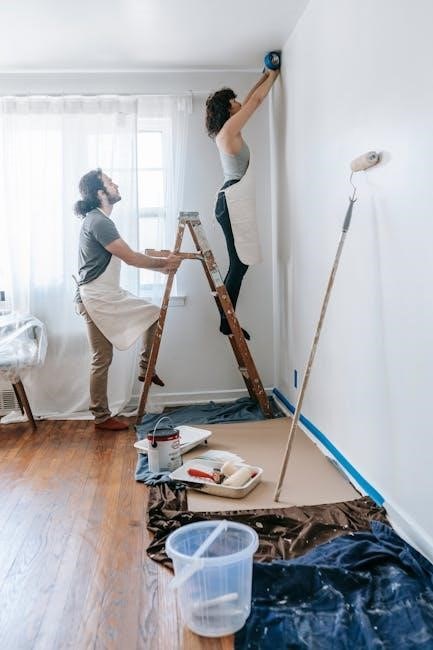
Durability and Longevity of Paint
Paint quality‚ surface prep‚ and environmental conditions significantly impact lifespan. High-quality paints resist fading and cracking‚ while proper maintenance extends durability‚ ensuring vibrant colors for years.
Factors Influencing Paint Lifespan
Several factors influence paint lifespan‚ including paint quality‚ surface preparation‚ and environmental conditions. High-quality paints with proper priming and application last longer. Exposure to sunlight‚ moisture‚ and temperature fluctuations can degrade paint faster. The finish type also matters‚ with glossy finishes being more durable. Regular maintenance‚ such as cleaning and touch-ups‚ extends paint life. Additionally‚ substrate material and paint color affect longevity‚ with darker colors fading more under UV light‚ and surface material compatibility plays a role.
Enhancing Paint Durability
Enhancing paint durability starts with proper surface preparation‚ including cleaning and filling cracks. Using a high-quality primer ensures better adhesion and longevity. Applying paint in thin‚ even coats allows proper drying between layers. Choosing mildew-resistant and UV-stable formulations helps withstand environmental stresses. Avoiding direct sunlight and extreme temperatures during application is crucial. Regular maintenance‚ such as touching up scratches and cleaning walls‚ extends paint life. These practices ensure a resilient‚ long-lasting finish.
Future Trends in Painting
Future trends in painting include eco-friendly materials‚ smart paints‚ and advanced finishes. Technology will revolutionize the industry‚ offering innovative solutions for durability and aesthetics.
Innovative Paint Technologies
Innovative paint technologies are transforming the industry with advancements like self-healing coatings‚ light-responsive paints‚ and antimicrobial formulations. Graphene-based paints offer enhanced durability‚ while self-cleaning surfaces reduce maintenance. Smart paints can adapt to environmental changes‚ improving energy efficiency. These cutting-edge solutions are not only eco-friendly but also provide functional benefits‚ making them integral to modern and future painting projects. They promise to revolutionize both aesthetics and performance in various applications.
Emerging Industry Developments
The painting industry is witnessing significant advancements‚ with a focus on sustainability and technology integration. Water-based and eco-friendly paints are gaining traction‚ reducing environmental impact. AI-driven color matching and robotic painting systems are streamlining processes. Additionally‚ advancements in spray technology and UV-curable coatings are improving efficiency. These developments are reshaping the market‚ offering consumers and professionals alike innovative solutions that balance performance‚ aesthetics‚ and environmental responsibility‚ setting new standards for the future of painting.





